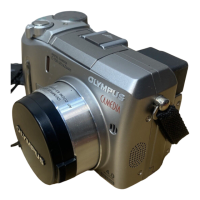SHORT COURSES HTTP://WWW.SHORTCOURSES.COM
15
Manual and press the Drive/Erase button until BKT is displayed.
2. Hold down the shutter button to take the series of pictures.
AUTOEXPOSURE BRACKETING SETTINGS
1. With the Mode Dial set to P or A/S/M, press OK/Menu to
display the top menu, then press the right arrow on the
arrow pad to display the Mode menu. With the CAMERA
tab highlighted, press the right arrow to activate the menu.
2. Press the up or down arrow on the arrow pad to highlight
BKT, then press the right arrow to cascade that menu.
3. Press the up or down arrow on the arrow pad to highlight
the change in exposure you want between each shot, then
press the right arrow to move to the next set of choices—
how many images to take in the series. Highlight x 3 or x 5
and press OK/Menu once to confirm your setting and
again to hide the menu.
4. Turn on bracketing as described in “Using Autoexposure
Bracketing.”
USING MULTI-METERING
1. Set the Mode Dial to P or any A/S/M mode other than
Manual and press the Macro/Spot button to turn on spot
metering (page 00).
2. Press OK/Menu to display the top menu, then press the
right arrow on the arrow pad to display the Mode menu.
With the CAMERA tab highlighted, press the right arrow to
activate the menu.
3. Press the up or down arrow on the arrow pad to highlight
MULTI METERING, then press the right arrow to display
your choices. Highlight ON and press OK/Menu once to
confirm your setting and again to hide the menu.
4. Aim the camera at up to 8 parts of the scene and press AEL
for each. When you do so, a metering bar is displayed at the
bottom of the screen and the aperture and shutter speed
based on the current average of all of your meter readings
are displayed.
■ The small dots below the scale indicate where readings
have been made.
■ The small dot above the scale indicates how much the
scene you are currently metering differs from the one
© COPYRIGHT 2001 BY DENNIS P. CURTIN
16
calculated by the camera.
5. When finished, repeat Steps 1–4 but select OFF. (For other
actions, see “Tips” to the left).
USING THE SELF-TIMER
1. With the Mode Dial set to any shooting mode other than
Auto, press the Drive/Erase button until the self-timer icon
(a clock face) is displayed.
2. Place the camera on a stable surface or tripod and compose
the picture.
3. To take the picture or start movie recording, press the
shutter button and the red self-timer light on the front of
the camera glows for 10 seconds and then blinks for the last
two. (To interrupt the timer without canceling it, press
Drive/Erase.) After taking the picture, the self-timer setting
is cancelled.
INCREASING SENSITIVITY (ISO)
1. With the Mode Dial set to P, A/S/M, or Movie mode, press
OK/Menu to display the Top menu.
■ In P or A/S/M mode, press the up arrow on the arrow
pad to select ISO and display a list of choices. Press the up
or down arrow on the arrow pad to select your choice.
■ In Movie mode, press the right arrow on the arrow pad
to display the Mode menu. With the CAMERA tab high-
lighted, press the right arrow to activate the menu. With
ISO highlighted, press the right arrow to display a list of
choices. Press the up or down arrow on the arrow pad to
highlight your choice.
2. Press OK/Menu once to confirm the setting and again to
hide the menu.
INCREASING SHARPNESS OF MOVING OBJECTS
■ Photograph fast-moving subjects heading toward or away
from you.
■ Move farther back from the subject.
■ Zoom the lens to a wider angle of view.
■ Switch to shutter-priority mode (page 27) and select a fast
shutter speed such as 1/500.
■ Increase the ISO although this adds some grain to the

